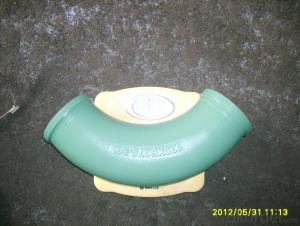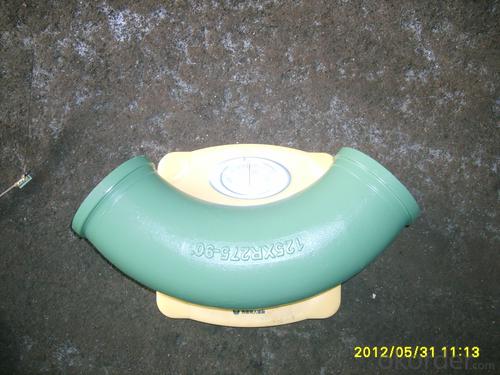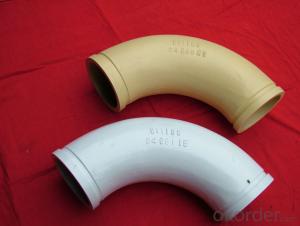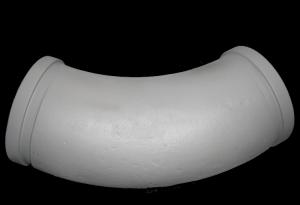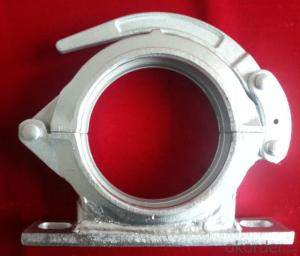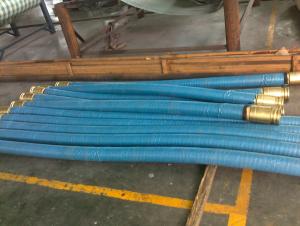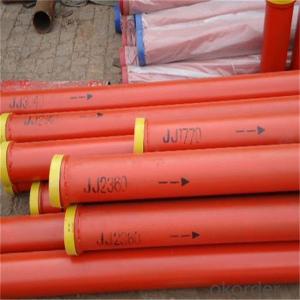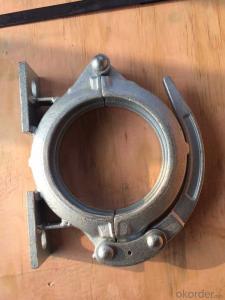Concrete Pump Truck Parts Elbow Bend R275 DN125 157Flange 45DGR Casting
- Loading Port:
- China Main Port
- Payment Terms:
- TT OR LC
- Min Order Qty:
- -
- Supply Capability:
- -
OKorder Service Pledge
Quality Product, Order Online Tracking, Timely Delivery
OKorder Financial Service
Credit Rating, Credit Services, Credit Purchasing
You Might Also Like
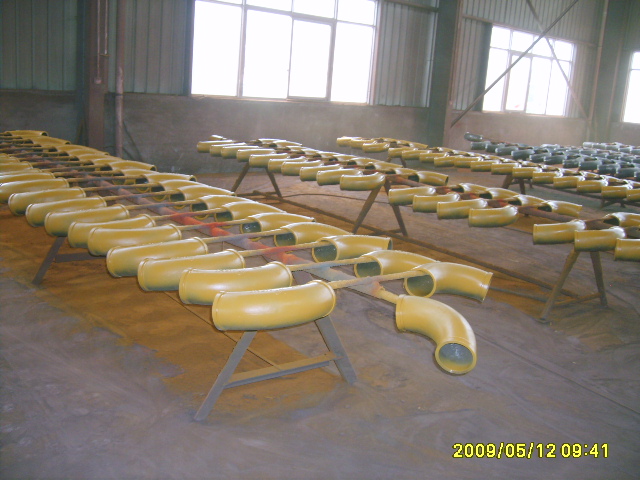
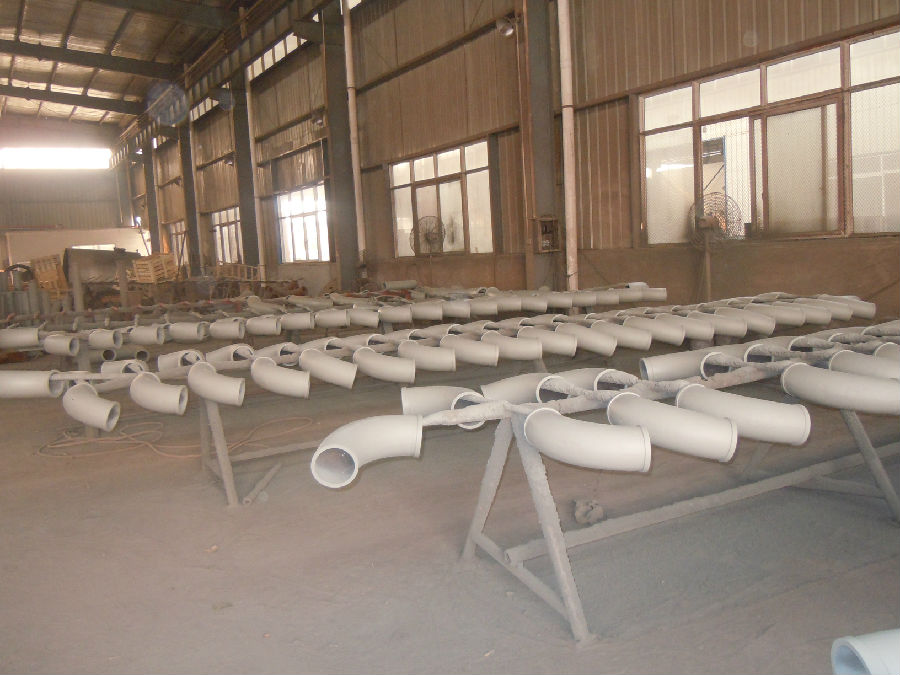
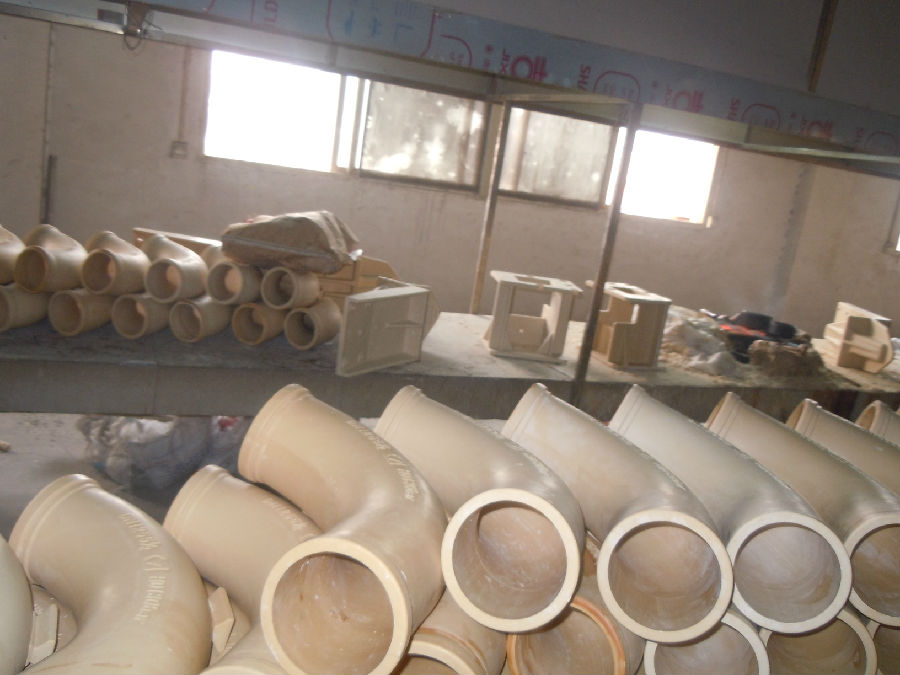


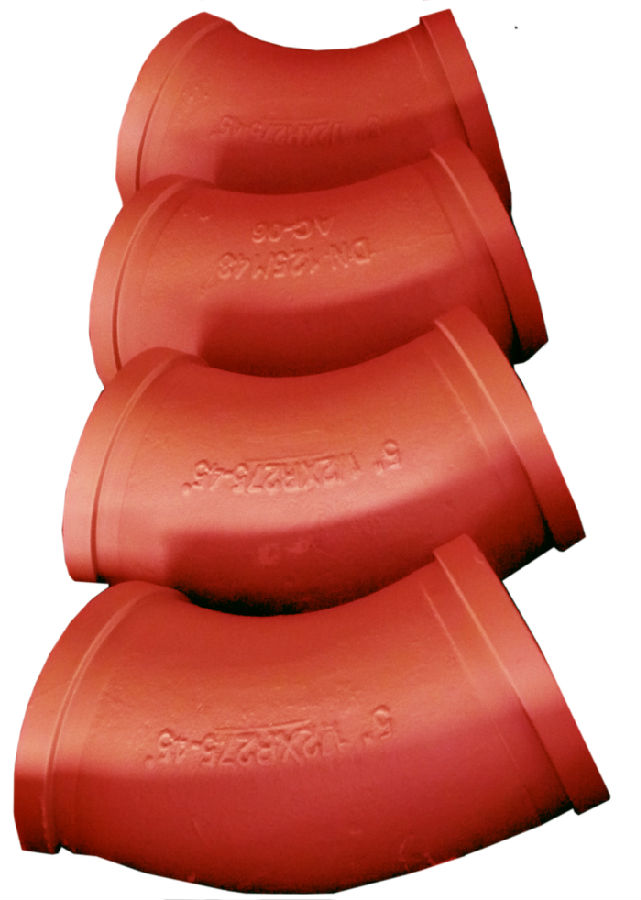
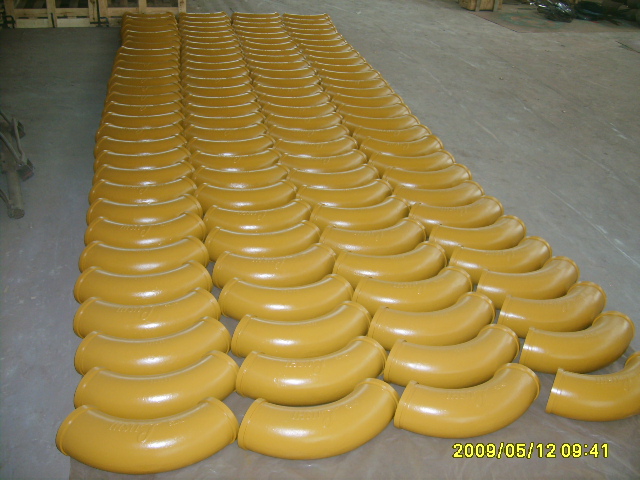
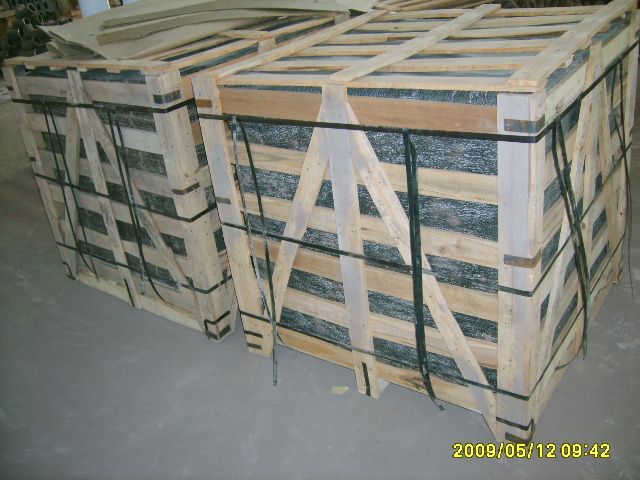
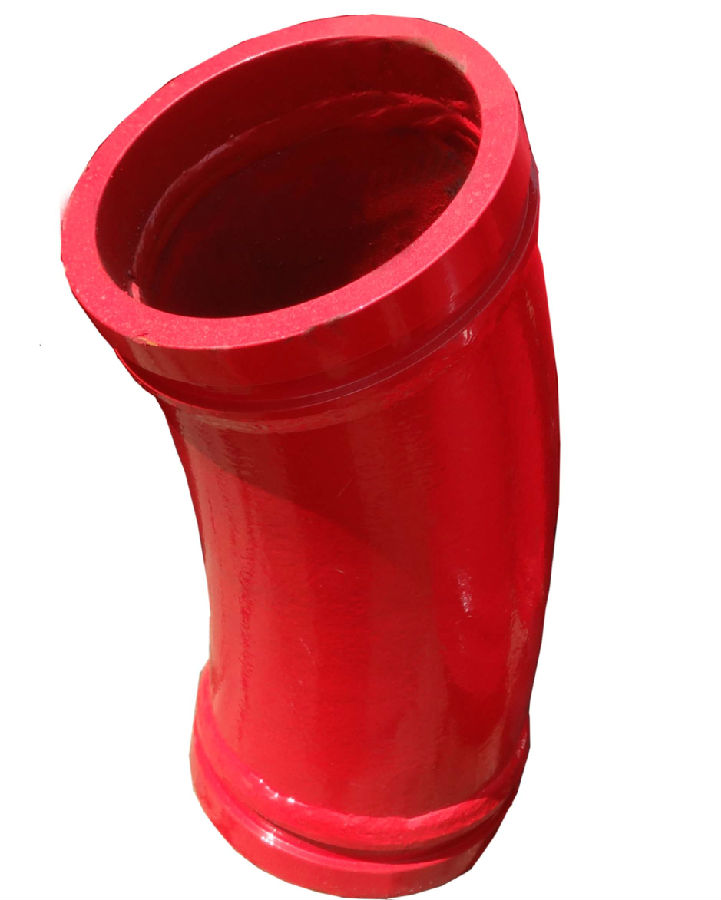
Product Description:
Product Name: Concrete Pump ELBOW DN125
1. Specification of Concrete Pump ELBOW DN125
Dimensions: DN125
Flange: SK, ZX, F&M
Degree: 45°
Material: #20 steel, ST52
Thickness: 4.5mm,6mm,7.1mm,7.5mm,10mm,
Working pressure: 180MPa
Notes: total series of concrete pump ELBOW for different brand concrete pump(PUTZMEISTER, SCHWING, CIFA, SANY, ZOOMLION, IHI, KYOKUTO Etc) available from us.
2. Application of Concrete Pump ELBOW DN125
Widely used on concrete pump truck, concrete placing boom, trailer concrete pump etc, for concrete delivery pipe connection.
Our concrete pump bends have been successfully exported to many countries from 1998, Our main markets as below: Middle East, Southeast Asia, America, Brazil, Italy, Russia, South Africa etc
Aiming at the largest concrete pump parts manufacturer, and reliable, professional supplier in China, we can supply concrete pump elbows, delivery pipes, casting or forging couplings, end rubber hoses, rubber pistons, tungsten wear plates, delivery cylinders, and other hydraulic parts, one stop service for your concrete pump parts and accessory business.
3. Package and Delivery of Concrete Pump ELBOW
Every 30pcs put in one seaworthy wooden box, and 20 boxes in one 20feet container.
Product Name: Concrete Pump ELBOW DN125
1. Specification of Concrete Pump ELBOW DN125
Dimensions: DN125
Flange: SK, ZX, F&M
Degree: 45°
Material: #20 steel, ST52
Thickness: 4.5mm,6mm,7.1mm,7.5mm,10mm,
Working pressure: 180MPa
Notes: total series of concrete pump ELBOW for different brand concrete pump(PUTZMEISTER, SCHWING, CIFA, SANY, ZOOMLION, IHI, KYOKUTO Etc) available from us.
2. Application of Concrete Pump ELBOW DN125
Widely used on concrete pump truck, concrete placing boom, trailer concrete pump etc, for concrete delivery pipe connection.
Our concrete pump bends have been successfully exported to many countries from 1998, Our main markets as below: Middle East, Southeast Asia, America, Brazil, Italy, Russia, South Africa etc
Aiming at the largest concrete pump parts manufacturer, and reliable, professional supplier in China, we can supply concrete pump elbows, delivery pipes, casting or forging couplings, end rubber hoses, rubber pistons, tungsten wear plates, delivery cylinders, and other hydraulic parts, one stop service for your concrete pump parts and accessory business.
3. Package and Delivery of Concrete Pump ELBOW
Every 30pcs put in one seaworthy wooden box, and 20 boxes in one 20feet container.
- Q: Can concrete pump spare parts be coated with anti-corrosion or anti-wear coatings?
- Yes, concrete pump spare parts can be coated with anti-corrosion or anti-wear coatings. These coatings provide an additional layer of protection to the spare parts, helping to prevent corrosion and wear caused by the harsh operating conditions and abrasive materials encountered in concrete pumping. The coatings are typically made from materials such as epoxy, polyurethane, or ceramic, which have excellent resistance to corrosion and wear. The application of these coatings can significantly extend the lifespan of concrete pump spare parts, reducing the need for frequent replacements and resulting in cost savings for operators. Additionally, the anti-corrosion and anti-wear coatings can improve the overall performance and efficiency of the concrete pump, ensuring smooth and reliable operation.
- Q: Are there any specific guidelines for the selection and installation of hydraulic components in concrete pump spare parts?
- Yes, there are specific guidelines for the selection and installation of hydraulic components in concrete pump spare parts. When choosing hydraulic components for concrete pump spare parts, it is important to consider factors such as the maximum operating pressure, flow rate, and compatibility with the existing hydraulic system. Firstly, it is crucial to ensure that the selected hydraulic components can handle the maximum operating pressure of the concrete pump. This includes components such as hydraulic cylinders, valves, and pumps. Choosing components with a higher pressure rating than the concrete pump's operating pressure can help ensure their durability and longevity. Secondly, the flow rate of the hydraulic components should match the requirements of the concrete pump system. Components such as hydraulic pumps and valves must be able to provide sufficient flow to operate the concrete pump effectively. It is important to consider factors such as the size of the concrete pump, the desired output capacity, and the specific pumping requirements. Moreover, compatibility with the existing hydraulic system is crucial for the smooth operation of the concrete pump. Hydraulic components should be selected based on their compatibility with the existing system in terms of fittings, connections, and overall design. It is advisable to consult the manufacturer's guidelines or seek professional advice when selecting and installing hydraulic components in concrete pump spare parts. Furthermore, proper installation is essential to ensure the optimal performance and safety of hydraulic components in concrete pump spare parts. It is recommended to follow the manufacturer's installation instructions and guidelines. The installation process should include proper alignment, secure mounting, and appropriate sealing of the components to prevent any leaks or failures. In conclusion, there are specific guidelines for the selection and installation of hydraulic components in concrete pump spare parts. Considering factors such as maximum operating pressure, flow rate, compatibility, and following proper installation procedures can help ensure the efficient and safe operation of the concrete pump system.
- Q: Are there any specific guidelines for the installation of pistons or cylinders in concrete pump spare parts?
- Yes, there are specific guidelines for the installation of pistons or cylinders in concrete pump spare parts. These guidelines are important to ensure proper functioning and longevity of the equipment. 1. Clean and inspect: Before installing pistons or cylinders, it is crucial to thoroughly clean and inspect them for any damage or defects. Any debris or contaminants should be removed to prevent potential issues during operation. 2. Lubrication: Apply a suitable lubricant to the piston or cylinder to reduce friction and ensure smooth movement. This will also help in preventing wear and tear, enhancing the lifespan of the parts. 3. Alignment: Proper alignment of the piston or cylinder is essential. Ensure that the piston is aligned correctly with the cylinder bore to avoid any binding or excessive wear. This can be achieved by following the manufacturer's instructions or consulting a professional if necessary. 4. Torque specifications: It is important to tighten the bolts or fasteners according to the manufacturer's recommended torque specifications. Over-tightening or under-tightening can lead to problems such as leaks or mechanical failure. 5. Sealing: Use appropriate sealing materials, such as gaskets or O-rings, to ensure a proper seal between the piston and cylinder. This will prevent fluid leakage and maintain the efficiency of the equipment. 6. Testing: After installation, it is recommended to test the pistons or cylinders to ensure they are functioning correctly. This can involve performing a trial run or conducting pressure tests to check for any leaks or abnormalities. Following these guidelines will help ensure the proper installation of pistons or cylinders in concrete pump spare parts, leading to reliable and efficient operation of the equipment. It is always advisable to refer to the manufacturer's instructions or seek professional assistance if there are any doubts or concerns during the installation process.
- Q: How can a malfunctioning remote control affect the pumping operation?
- The pumping operation can be significantly affected in multiple ways by a malfunctioning remote control. Initially, operators utilize the remote control to operate the pump from a distance, enabling them to control crucial settings such as speed and direction. If the remote control malfunctions, it can hinder operators' ability to effectively control the pump, resulting in delays or inefficiencies in the operation. Furthermore, a malfunctioning remote control can lead to inconsistent or erratic commands being sent to the pump. This instability in commands can cause fluctuation in flow rates, pressure, or other critical parameters, thereby impacting the overall efficiency and effectiveness of the pumping operation. Moreover, there are safety risks associated with a malfunctioning remote control. If the remote control fails to transmit accurate commands, it may cause the pump to operate at undesired speeds or pressures, potentially leading to equipment damage or accidents. Additionally, during emergencies or hazardous situations, the inability to control the pump remotely can hinder operators' prompt response and risk mitigation. Additionally, a malfunctioning remote control can disrupt the monitoring and control systems linked to the pumping operation. Remote controls are often integrated with centralized monitoring systems that provide real-time data and alerts to operators. If the remote control fails, it can interrupt the flow of critical information, making it challenging for operators to monitor the pump's performance, identify issues, or make informed decisions. To conclude, the malfunctioning of a remote control can adversely affect the pumping operation by impeding remote control functionality, causing erratic pump performance, posing safety risks, and hindering monitoring and control systems. Therefore, it is essential to regularly inspect and maintain remote controls to ensure their proper functionality and minimize any potential disruptions to the pumping operation.
- Q: What are the signs of a malfunctioning lubrication system?
- Some signs of a malfunctioning lubrication system include increased friction and heat, unusual noises coming from the engine or components, excessive wear and tear on moving parts, and a decrease in overall performance and efficiency of the machinery or vehicle.
- Q: How can a damaged concrete pump hopper affect the pumping process?
- A damaged concrete pump hopper can significantly impact the pumping process as it plays a crucial role in the overall efficiency and functionality of the equipment. Firstly, a damaged hopper can lead to a decrease in the pump's performance by causing blockages or clogs in the system. This can result in disruption or even a complete halt to the pumping process, leading to delays and increased downtime. Secondly, a damaged hopper can also lead to a loss of concrete, as it may leak or spill during the pumping operation. This not only wastes material but can also create safety hazards and environmental concerns. Therefore, it is essential to promptly address any damage to the concrete pump hopper to ensure smooth and efficient pumping operations.
- Q: How often should wear rings be replaced in a concrete pump?
- Wear rings in a concrete pump should be replaced regularly, typically every 2,000 to 3,000 hours of operation. However, the frequency may vary depending on factors such as pump usage, maintenance practices, and the quality of materials being pumped. Regular inspection and monitoring of wear ring condition are essential to determine the appropriate replacement interval.
- Q: How can one identify the correct thread size and type for concrete pump spare parts?
- To identify the correct thread size and type for concrete pump spare parts, one can start by consulting the manufacturer's specifications and documentation. These resources often provide detailed information on the thread size and type used in the equipment. Additionally, measuring the existing thread on the spare part or the corresponding component can help determine the correct thread size and type. Utilizing thread gauges or consulting a professional in the industry can also provide accurate identification of the required thread size and type for concrete pump spare parts.
- Q: How can a faulty battery affect the operation of the pump?
- A faulty battery can significantly affect the operation of a pump. Firstly, a faulty battery may not provide enough power to the pump, resulting in slow or weak pumping action. This can impact the pump's ability to generate the necessary pressure or flow rate, leading to inefficient or ineffective operation. Additionally, a faulty battery may cause intermittent power supply to the pump. This can result in inconsistent pumping action, with the pump starting and stopping sporadically. Such interruptions can create inefficiencies, reduce the pump's performance, and potentially cause damage to the equipment or system being operated. Furthermore, a faulty battery may not hold a charge for an extended period. This can limit the pump's runtime, requiring frequent recharging or replacement of the battery. In scenarios where a pump is needed for continuous or prolonged usage, a faulty battery can disrupt operations, leading to downtime and reduced productivity. Moreover, a faulty battery can also impact the overall lifespan of the pump. If the battery does not provide the necessary power consistently, the pump may experience strain or excessive wear, potentially shortening its operational life. Overall, a faulty battery can have various adverse effects on the operation of a pump, including reduced performance, inconsistent pumping action, limited runtime, potential damage, and decreased equipment lifespan. Regular maintenance and timely replacement of faulty batteries are crucial to ensure optimal pump performance and longevity.
- Q: How often should the concrete pump cylinder be replaced?
- The frequency at which the concrete pump cylinder needs to be replaced depends on various factors such as the amount of usage, the quality of concrete being pumped, and the maintenance and care given to the pump. Typically, a concrete pump cylinder can last for several years if properly maintained and serviced regularly. However, it is recommended to inspect the cylinder for signs of wear and tear on a regular basis and replace it whenever there are noticeable signs of damage or deterioration. It is always better to be proactive and replace the cylinder before it fails completely to avoid any potential accidents or disruptions in the pumping process. Ultimately, it is best to consult the manufacturer's guidelines and recommendations regarding the replacement interval for the specific make and model of the concrete pump cylinder being used.
Send your message to us
Concrete Pump Truck Parts Elbow Bend R275 DN125 157Flange 45DGR Casting
- Loading Port:
- China Main Port
- Payment Terms:
- TT OR LC
- Min Order Qty:
- -
- Supply Capability:
- -
OKorder Service Pledge
Quality Product, Order Online Tracking, Timely Delivery
OKorder Financial Service
Credit Rating, Credit Services, Credit Purchasing
Similar products
Hot products
Hot Searches
Related keywords
